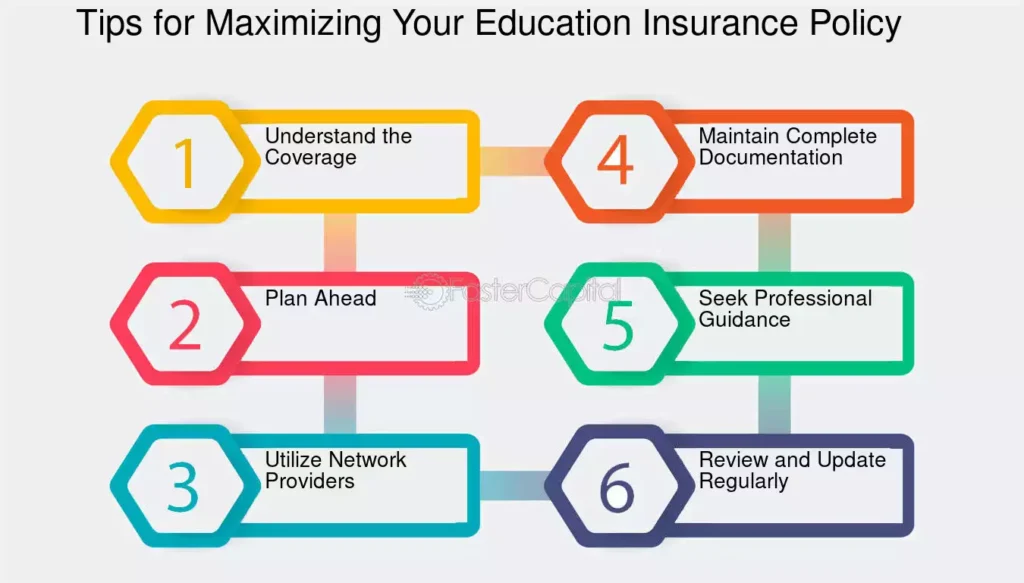Education insurance is a monetary item intended to secure a child’s educational future by providing assets for their schooling if unanticipated circumstances occur. It guarantees that guardians or guardians can meet the expenses of tutoring, including educational fees, books, and other related costs, regardless of whether the child faces startling monetary difficulties like sickness, inability, or passing.
This kind of protection commonly combines life insurance with a venture component, offering a safety net for long-term educational preparation. Training insurance contracts are frequently adjustable, considering adaptable inclusion choices based on the child’s age, educational objectives, and the family’s financial situation. With the increasing costs of education, this protection provides an inner sense of harmony, guaranteeing that a child’s educational journey stays continuous, paying little attention to monetary vulnerabilities.
What Is Education Insurance?
Training insurance is a type of extra security contract that combines the advantages of education investment funds and disaster protection. It is a strategy explicitly intended to assist guardians or watchmen with gathering the assets required for their child’s education. Depending on the particular arrangement, schooling insurance might be a term disaster protection contract, an entire life contract, or a venture-connected protection plan.
The essential objective of training protection is to guarantee that a youngster’s instructive necessities are met, regardless of whether the crucial provider or the policyholder dies out of the blue. Some training protection designs likewise consider single-amount payouts that can be utilized for educational costs, books, school charges, or other instructive costs, either during the youngster’s tutoring or at the hour of college or school schooling.
Introduction to Education Insurance
Training insurance is a contract that guarantees monetary security for a youngster’s instructive costs. It is intended to assist guardians or gatekeepers with putting something aside for their kid’s schooling ahead of time.

The primary goal of training protection is to provide a single sum or expected payouts to cover the expenses related to the kid’s tutoring, school, or college instruction. It is constructive if unexpected occasions like the policyholder’s demise or inability arise, guaranteeing that the kid’s schooling goes on without monetary disturbance.
Key Features of Education Insurance
Education insurance policies are built to secure the future of a child’s education. Some of the key features include:
- Guaranteed Payout: A fixed amount of money is paid to the policyholder or beneficiary to cover education expenses.
- Flexibility: Policies are flexible in terms of premium payment frequency and the amount.
- Life Insurance Element: Many education insurance policies also include life insurance, providing additional security to the family in case of the policyholder’s death.
- Accidental Death Coverage: In some policies, if the policyholder dies due to an accident, the insurance company may pay an additional benefit.
- Tax Benefits: In many countries, premiums paid for education insurance are eligible for tax deductions.
Types of Education Insurance Policies
Education insurance policies come in various types to cater to different needs:

- Premium Payment Plan: This plan requires the policyholder to pay premiums over a set period (e.g., 10 or 15 years). Once the child reaches the age to start higher education, the policy provides the sum assured for their education.
- Single Premium Plan: A lump sum amount is paid upfront, and no further premiums are required. The policyholder can rest assured that the child’s education expenses will be covered in the future.
- Regular Premium Plan: The policyholder pays premiums on a regular basis (monthly, quarterly, or annually), and the insurance company accumulates funds for the child’s education.
- Child Education Endowment Plan: A combination of life insurance and investment, this policy offers both a life cover and a savings component for future educational needs.
Premium Payment Options
Premiums for education insurance policies can be paid in several ways:
- Monthly Premiums: Payments are made monthly. This is a good option for those who prefer smaller, manageable amounts.
- Quarterly Premiums: Payments are made every three months.
- Annual Premiums: Premiums are paid once a year. Some policies may offer discounts for yearly payments.
- Lump Sum Payment: A one-time hefty premium is paid at the beginning, and no further payments are required. The choice of premium payment method depends on the policyholder’s financial situation and preferences.
Policy Duration
The term of the instruction insurance contract ordinarily ranges from the time the contract is bought until the child finishes school. The strategy is organized to guarantee that the monetary sum expected for instructional costs is accessible when required.

Most strategies last between 10 and 20 years. The policyholder can pick a length that aligns with the youngster’s age and the expected time for advanced education. For example, assuming the kid is conceived, the arrangement could go on until the youngster turns 18 or 21, covering their whole instructive excursion.
Life Insurance Feature in Education Insurance
One critical advantage of instruction protection is that it frequently incorporates an extra security component. If the policyholder bites the dust before the kid’s schooling is financed, the insurance agency will, in any case, guarantee that the youngster’s schooling is paid for.
This element is especially significant for families where the essential provider’s pay is critical for financing the child’s schooling. The life coverage component guarantees that the child’s future schooling costs are covered, no matter the policyholder’s conditions.
Tax Benefits of Education Insurance
In many countries, education insurance policies offer tax advantages to policyholders. These benefits can include:

- Tax Deduction on Premiums: The premiums paid towards an education insurance policy are often eligible for tax deductions under specific sections of tax laws (e.g., Section 80C in India).
- Tax-Free Payouts: In some cases, the lump sum or periodic payouts received under the policy may be tax-free, allowing the funds to be fully utilized for educational expenses. It is essential to consult a tax professional to understand the specific tax benefits available in your country, as these can vary based on local tax laws.
Benefits of Education Insurance
Education insurance offers several advantages:
- Financial Security: It ensures that the child’s education will not be interrupted due to unforeseen financial hardships.
- Early Savings: By starting early, parents can accumulate a significant amount of money for future educational expenses.
- Avoiding Loans: Education insurance reduces the need to take out student loans or borrow money for educational expenses.
- Peace of Mind: It provides peace of mind to parents, knowing that their child’s future education is financially secure.
- Dual Benefit: Many policies offer both an investment component and a life insurance cover, making them a dual-purpose financial tool.
Drawbacks of Education Insurance
While education insurance has many advantages, there are some potential drawbacks:
- High Premiums: Some policies may have high premiums, especially those with a life insurance component, which can be a financial burden for some families.
- Complex Terms: The terms and conditions of education insurance policies can be complex and challenging to understand, which may confuse policyholders.
- Limited Coverage: Some policies may only cover specific educational expenses, such as tuition fees, and may not include other costs like books, extracurricular activities, or hostel fees.
- Low Returns: Some education insurance policies may offer lower returns compared to other investment options, such as mutual funds or fixed deposits.
Is Education Insurance Right for You?
Education insurance may be suitable for you if:
- You want to secure your child’s education: If you want to ensure that your child’s education is financially protected, even in case of an emergency, education insurance can be an excellent option.
- You have the financial capacity: Education insurance requires regular premium payments, so it is ideal for those who can afford to commit to long-term payments.
- You are looking for a dual benefit: If you want both life insurance and a savings component to fund your child’s education, education insurance provides this dual benefit. However, it may not be ideal if you are looking for higher returns on investment, as education insurance may not always offer the best returns compared to other investment avenues.
Frequently Asked Questions
What is instruction protection?
Training insurance is a contract that guarantees monetary help for a child’s schooling in the event of unanticipated occasions like disease, handicap, or the demise of the parent or guardian.
How does instruction protection function?
It consolidates extra security with a speculation part, where expenses are paid consistently. In the event of a crisis, the arrangement pays out to cover instructive costs.
Who can purchase schooling protection?
Guardians, gatekeepers, or anybody liable for a youngster’s schooling can buy training protection.
What does the approach cover?
It covers educational expenses, school-related costs, and, in some cases, considerably advanced education costs like school or college charges.
Is it a drawn-out strategy?
Indeed, training insurance is commonly a drawn-out contract that goes on until the kid arrives at the period of schooling.
How much inclusion?
Indeed, inclusion can be custom-made in view of your kid’s future training costs.
Are expenses adaptable?
Indeed, expenses can be changed by your monetary circumstances and the kid’s age.
Is the arrangement charge deductible?
In numerous nations, charges might fit the bill for tax reductions.
Cand, can I pull out assets before development?
A few strategies permit fractional withdrawal, but their terms differ.
How would I guarantee the arrangement?
Claims are made by giving fundamental records like clinical reports, passing endorsements, and so forth.
Contingent upon the circumstance.
Conclusion
Training protection is an essential device for getting your kid’s future instructive requirements. It offers a mix of monetary security, reserve funds, and disaster protection, guaranteeing that your youngster’s schooling stays continuous, even despite unexpected conditions. In any case, prior to buying a training insurance contract, it is vital to completely figure out the terms, expenses, and possible returns. Gauging the advantages against the disadvantages and taking into account what is happening will assist you with deciding if training protection is the best decision for yourself as well as your loved ones.




